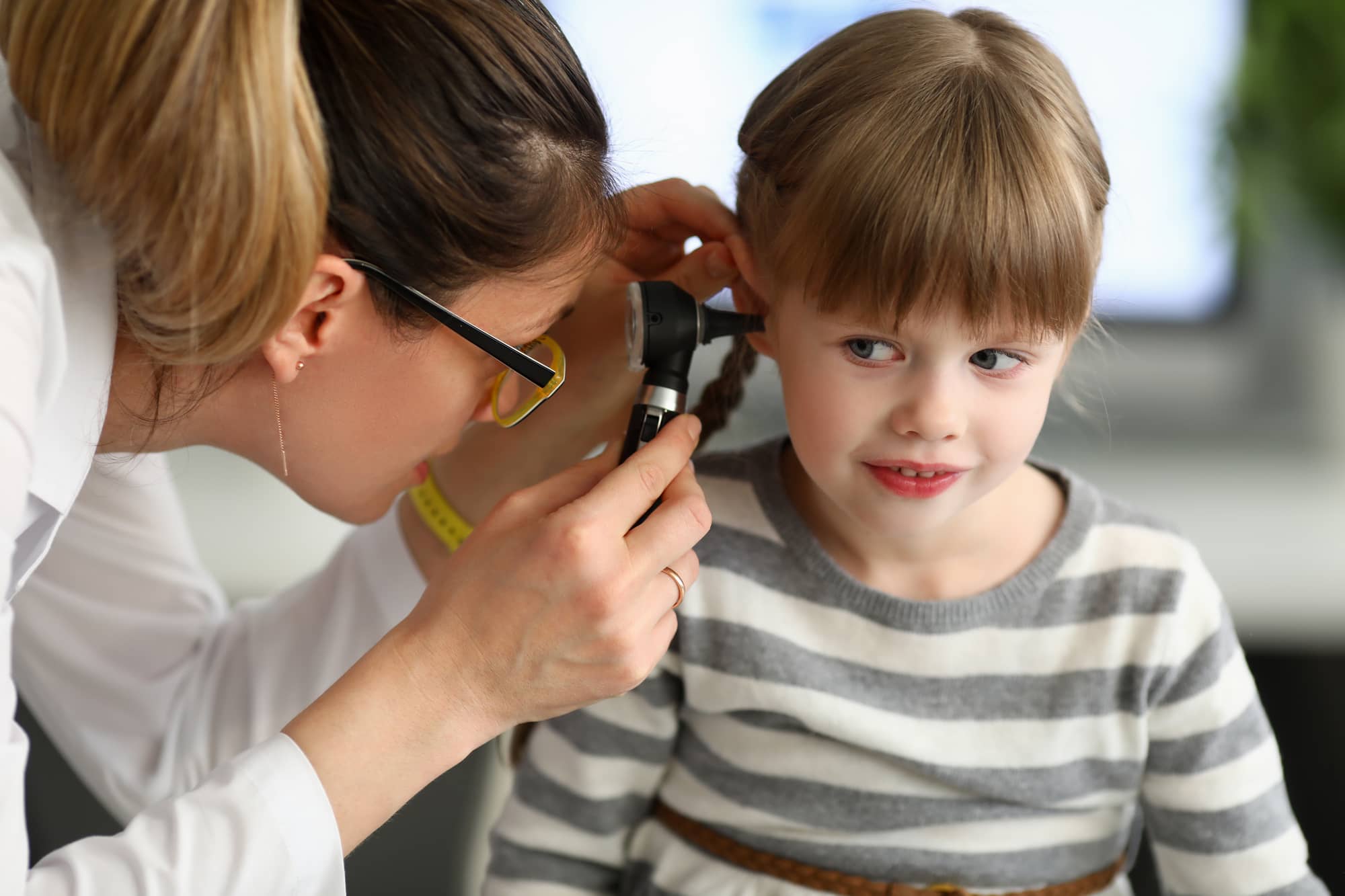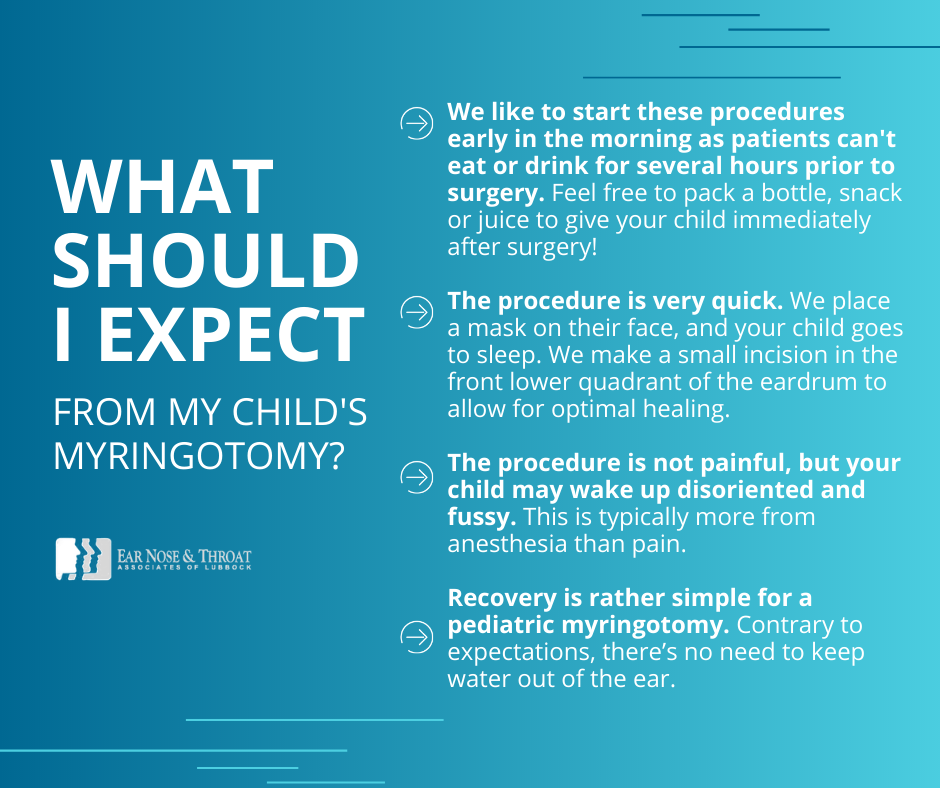The Parents’ Guide to Pediatric Myringotomy (Ear Tubes)

Only a parent who’s dealt with a child struggling with ear pain fully understands the significance of a promise of relief. The constant ear infections, discomfort, and sleepless nights leaves you looking at any and every solution that might alleviate your child’s pain.
If you’re considering a pediatric myringotomy to relieve your child’s chronic ear trouble, here’s what you need to know.
What is a Pediatric Myringotomy?
Myringotomy means “lancing the eardrum” — it’s the process of making a small incision in the eardrum to drain the fluid out. Without tube placement, this incision would heal within two weeks and the problems would quickly return. When we couple a myringotomy with a tube placement, we more effectively treat the problem and prevent the return of an infection.
In a pediatric myringotomy, we place very small tubes (slightly over 1 mm in diameter) in this small incision to keep the eardrum open for 6-12 months. These tubes ventilate the ear, making it healthier and drastically decreasing the chance of infection.
Why Some Babies Need Ear Tubes
Chronic fluid and infection in the middle ear that doesn’t clear with antibiotics is the primary reason for a tube placement. If we continue to leave this fluid or only address it with antibiotics, we see three potential negative results:
- Hearing loss, which results in language loss (especially during these early years of language acquisition)
- Middle ear bone and ear drum damage
- GI issues or oral thrush from repeated antibiotic use
Tubes are not specifically meant to drain fluid. Instead, as they ventilate the ear, it gets healthier and the ear drum resumes normal function. By placing a tube in the ear, we hope to ventilate for a long enough period that the child grows out of this stage of repeated infections.
How To Know If You Should Consider a Pediatric Myringotomy
As with any child health concern, start with the guidance of a trusted pediatrician. Pediatricians are conservative, giving ample time for the ears to heal with antibiotics before making a reference for tube placement.
Once your pediatrician refers you to an ENT, we’ll be persistent in looking for fluid on the ear and signs of multiple infections. We conduct pediatric diagnostic tests for a myringotomy such as pressure testing, flat tracings, and conductive hearing loss to check for fluid. We look for confirmatory evidence in these pediatric diagnostic tests to validate the diagnosis of recurring ear infections before we consider a myringotomy.
Benefits of Ear Tubes
If a child has chronic fluid and infections, the pain can last for months. After a tube placement, these children experience improved hearing and decreased damage to the ear.
Plus, they’re finally able to stop taking the antibiotics that may be causing additional issues.
Risks of Ear Tubes
This is a short procedure with minimal risk. The procedure only takes about ten minutes.
During the procedure, we use a mask for anesthesia. Any use of anesthesia comes with risks; however, we minimize these risks by conducting the procedure at a surgical center under careful monitoring of an experienced Anesthesiologist.
We do not intubate or use an IV for a myringotomy.

How to Prepare for Your Child’s Pediatric Myringotomy
We like to start these procedures early in the morning as patients cannot eat or drink for several hours prior to surgery. We don’t want children to wait and get fussy as the day progresses, so we usually begin surgery at 7 am. Be ready to get up early and feel free to pack a bottle, snack or juice to give your child immediately after surgery!
Other specifics will be addressed by the surgical center. Make sure to complete all paperwork and discuss any other questions you may have before the procedure.
What to Expect During a Myringotomy
The procedure is very quick. We place a mask on the face, and the child goes to sleep. Using a microscope, we clean the ear of wax and prep it with rubbing alcohol.
We make a small incision in the front lower quadrant of the eardrum to allow for optimal healing. After we make the incision, we suction the infected fluid out and slip the tube in. We use a small grommet tube that typically remains about one year before they work their way out of the ear on their own.
If a child has more chronically diseased ears the tubes may come out sooner and may require repeat tube placement. Long-term tubes that will eventually require removal are also an option for a very small number of patients, but we like to avoid these for as long as possible.
Is a Myringotomy Painful?
The procedure is not painful, but children may wake up disoriented and fussy. This is typically more from anesthesia than pain. Typically this disorientation lasts about 15 minutes, then they feel normal later in the day.
What to Expect For Your Child’s Recovery
Recovery is rather simple for a pediatric myringotomy. Contrary to expectations, there’s no need to keep water out of the ear. The tube has such a small diameter, water can’t enter the tube or cause infection. Because of this, a child can bathe or swim as normal.
However, if a child has another infection in the body, they might experience a middle ear infection as well. They’re actually more likely to get an infection from within themselves than from water. If the ear has drainage, we treat that with an antibiotic steroid. For the most part, drainage is a sign of infection and requires treatment.
Two weeks after the procedure, we schedule a follow-up appointment to repeat the hearing test to make sure hearing is normal.
Then, every 6-12 months, we schedule a follow-up to check on the ears until the tubes come out and the ears have fully healed. For some children, these problems resolve around age two. For others, problems may last longer, even into adulthood for a select few.
If you’re trying to determine the best solution to your child’s chronic ear infections, consider visiting an ENT to discuss your options. After they evaluate the pediatric diagnostic tests for a myringotomy, they’ll be able to make a recommendation that specifically addresses the needs of your child to provide them the relief you both need.
Dr. Scolaro is a board-certified Otolaryngologist servicing the South Plains area. He has been practicing in Lubbock since 1990 and has earned a reputation as a skilled and experienced surgeon. He currently serves as the Medical Director for Covenant High Plains Surgery Center campuses, is a member of Covenant Health Partners and is an adjunct faculty professor for Texas Tech University Health Sciences Center School of Medicine. Learn more about Dr. Scolaro.
Categories:








